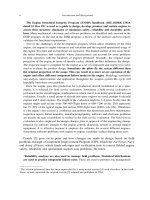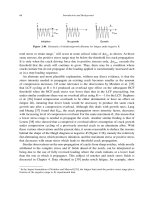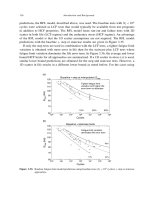Mechanics.Of.Materials.Saouma Episode 3 docx
Bạn đang xem bản rút gọn của tài liệu. Xem và tải ngay bản đầy đủ của tài liệu tại đây (479.14 KB, 20 trang )
Draft
2.5 †Simplified Theories; Stress Resultants 9
Show that the transformation tensor of direction cosines previously determined transforms the orig-
inal stress tensor into the diagonal principal axes stress tensor.
Solution:
From Eq. 2.38
σ =
0
1
√
2
−
1
√
2
1
√
3
−
1
√
3
−
1
√
3
−
2
√
6
−
1
√
6
−
1
√
6
311
102
122
0
1
√
3
−
2
√
6
1
√
2
−
1
√
3
−
1
√
6
−
1
√
2
−
1
√
3
−
1
√
6
(2.46-a)
=
−200
010
004
(2.46-b)
2.5 †Simplified Theories; Stress Resultants
34 For many applications of continuum mechanics the problem of determining the three-dimensional
stress distribution is too difficult to solve. However, in many (civil/mechanical)applications, one or more
dimensions is/are small compared to the others and possess certain symmetries of geometrical shape and
load distribution.
35 In those cases, we may apply “engineering theories” for shells, plates or beams. In those problems,
instead of solving for the stress components throughout the body, we solve for certain stress resultants
(normal, shear forces, and Moments and torsions) resulting from an integration over the body. We
consider separately two of those three cases.
36 Alternatively, if a continuum solution is desired, and engineering theories prove to be either too
restrictive or inapplicable, we can use numerical techniques (such as the Finite Element Method)to
solve the problem.
2.5.1 Shell
37 Fig. 2.5 illustrates the stresses acting on a differential element of a shell structure. The resulting
forces in turn are shown in Fig. 2.6 and for simplification those acting per unit length of the middle
surface are shown in Fig. 2.7. The net resultant forces are given by:
Victor Saouma Mechanics of Materials II
Draft
10 KINETICS
Figure 2.5: Differential Shell Element, Stresses
Figure 2.6: Differential Shell Element, Forces
Victor Saouma Mechanics of Materials II
Draft
2.5 †Simplified Theories; Stress Resultants 11
Figure 2.7: Differential Shell Element, Vectors of Stress Couples
Membrane Force
N =
+
h
2
−
h
2
σ
1 −
z
r
dz
N
xx
=
+
h
2
−
h
2
σ
xx
1 −
z
r
y
dz
N
yy
=
+
h
2
−
h
2
σ
yy
1 −
z
r
x
dz
N
xy
=
+
h
2
−
h
2
σ
xy
1 −
z
r
y
dz
N
yx
=
+
h
2
−
h
2
σ
xy
1 −
z
r
x
dz
Bending Moments
M =
+
h
2
−
h
2
σz
1 −
z
r
dz
M
xx
=
+
h
2
−
h
2
σ
xx
z
1 −
z
r
y
dz
M
yy
=
+
h
2
−
h
2
σ
yy
z
1 −
z
r
x
dz
M
xy
= −
+
h
2
−
h
2
σ
xy
z
1 −
z
r
y
dz
M
yx
=
+
h
2
−
h
2
σ
xy
z
1 −
z
r
x
dz
Transverse Shear Forces
Q =
+
h
2
−
h
2
τ
1 −
z
r
dz
Q
x
=
+
h
2
−
h
2
τ
xz
1 −
z
r
y
dz
Q
y
=
+
h
2
−
h
2
τ
yz
1 −
z
r
x
dz
(2.47)
2.5.2 Plates
38 Considering an arbitrary plate, the stresses and resulting forces are shown in Fig. 2.8, and resultants
Victor Saouma Mechanics of Materials II
Draft
12 KINETICS
Figure 2.8: Stresses and Resulting Forces in a Plate
per unit width are given by
Membrane Force N =
t
2
−
t
2
σdz
N
xx
=
t
2
−
t
2
σ
xx
dz
N
yy
=
t
2
−
t
2
σ
yy
dz
N
xy
=
t
2
−
t
2
σ
xy
dz
Bending Moments M =
t
2
−
t
2
σzdz
M
xx
=
t
2
−
t
2
σ
xx
zdz
M
yy
=
t
2
−
t
2
σ
yy
zdz
M
xy
=
t
2
−
t
2
σ
xy
zdz
Transverse Shear Forces V =
t
2
−
t
2
τ dz
V
x
=
t
2
−
t
2
τ
xz
dz
V
y
=
t
2
−
t
2
τ
yz
dz
(2.48-a)
39 Note that in plate theory, we ignore the effect of the membrane forces, those in turn will be accounted
for in shells.
Victor Saouma Mechanics of Materials II
Draft
Chapter 3
MATHEMATICAL
PRELIMINARIES; Part II
VECTOR DIFFERENTIATION
3.1 Introduction
1 A field is a function defined over a continuous region. This includes, Scalar Field (such as tempera-
ture) g(x), Vector Field (such as gravity or magnetic) v(x), Fig. 3.1 or Tensor Field T(x).
2 We first introduce the differential vector operator “Nabla” denoted by ∇
∇ ≡
∂
∂x
i +
∂
∂y
j +
∂
∂z
k
(3.1)
3 We also note that there are as many ways to differentiate a vector field as there are ways of multiplying
vectors, the analogy being given by Table 3.1.
Multiplication Differentiation Tensor Order
u·v dot ∇·v divergence
❄
u×v cross ∇×v curl
✲
u ⊗ v tensor ∇v gradient
✻
Table 3.1: Similarities Between Multiplication and Differentiation Operators
3.2 Derivative WRT to a Scalar
4 The derivative of a vector p(u) with respect to a scalar u, Fig. 3.2 is defined by
dp
du
≡ lim
∆u→0
p(u +∆u) − p(u)
∆u
(3.2)
5 If p(u)isaposition vector p(u)=x(u)i + y(u)j + z(u)k, then
dp
du
=
dx
du
i +
dy
du
j +
dz
du
k (3.3)
Draft
2 MATHEMATICAL PRELIMINARIES; Part II VECTOR DIFFERENTIATION
‡ Scalar and Vector Fields
ContourPlot@Exp@−Hx^2 + y^2LD, 8x, −2, 2<, 8y, − 2, 2<, ContourShading −> FalseD
-2 -1 0 1 2
-2
-1
0
1
2
Ö ContourGraphics Ö
Plot3D@Exp@−Hx^2 + y^2LD, 8x, − 2, 2<, 8y, − 2, 2<, FaceGrids −> AllD
-2
-1
0
1
2
-2
-1
0
1
2
0
0.25
0.5
0.75
1
-
2
-1
0
1
Ö SurfaceGraphics Ö
m−fields.nb 1
Figure 3.1: Examples of a Scalar and Vector Fields
(u+ u)
∆
C
(u)
p
p
p
(u+ u)- (u)
=
∆
p
p
∆
Figure 3.2: Differentiation of position vector p
Victor Saouma Mechanics of Materials II
Draft
3.2 Derivative WRT to a Scalar 3
is a vector along the tangent to the curve.
6 If u is the time t, then
dp
dt
is the velocity
7 †In differential geometry, if we consider a curve C defined by the function p(u) then
dp
du
is a vector
tangent ot C,andifu is the curvilinear coordinate s measured from any point along the curve, then
dp
ds
is a unit tangent vector to C T, Fig. 3.3. and we have the following relations
C
T
N
B
Figure 3.3: Curvature of a Curve
dp
ds
= T (3.4)
dT
ds
= κN (3.5)
B = T×N (3.6)
κ curvature (3.7)
ρ =
1
κ
Radius of Curvature (3.8)
we also note that p·
dp
ds
=0if
dp
ds
=0.
Example 3-1: Tangent to a Curve
Determine the unit vector tangent to the curve: x = t
2
+1,y =4t −3, z =2t
2
− 6t for t =2.
Solution:
dp
dt
=
d
dt
(t
2
+1)i +(4t −3)j +(2t
2
− 6t)k
=2ti +4j +(4t − 6)k (3.9-a)
dp
dt
=
(2t)
2
+ (4)
2
+(4t − 6)
2
(3.9-b)
T =
2ti +4j +(4t −6)k
(2t)
2
+ (4)
2
+(4t − 6)
2
(3.9-c)
=
4i +4j +2k
(4)
2
+ (4)
2
+ (2)
2
=
2
3
i +
2
3
j +
1
3
k for t = 2 (3.9-d)
Mathematica solution is shown in Fig. 3.4
Victor Saouma Mechanics of Materials II
Draft
4 MATHEMATICAL PRELIMINARIES; Part II VECTOR DIFFERENTIATION
‡ Parametric Plot in 3D
ParametricPlot3D@8t^2 + 1, 4 t − 3, 2 t^2 − 6t<, 8t, 0, 4<D
0
5
10
15
0
5
10
0
5
0
5
10
15
0
5
10
Ö Graphics3D Ö
m−par3d.nb 1
Figure 3.4: Mathematica Solution for the Tangent to a Curve in 3D
3.3 Divergence
3.3.1 Vector
8 The divergence of a vector field of a body B with boundary Ω, Fig. 3.5 is defined by considering
that each point of the surface has a normal n, and that the body is surrounded by a vector field v(x).
The volume of the body is v(B).
v(x)
B
Ω
n
Figure 3.5: Vector Field Crossing a Solid Region
9 The divergence of the vector field is thus defined as
∇·v =divv(x) ≡ lim
v(B)→0
1
v(B)
Ω
v·ndA
(3.10)
where v.n is often referred as the flux and represents the total volume of “fluid” that passes through
dA in unit time, Fig. 3.6 This volume is then equal to the base of the cylinder dA times the height of
Victor Saouma Mechanics of Materials II
Draft
3.3 Divergence 5
v
Ω
v.n
dA
n
Figure 3.6: Flux Through Area dA
the cylinder v·n. We note that the streamlines which are tangent to the boundary do not let any fluid
out, while those normal to it let it out most efficiently.
10 The divergence thus measure the rate of change of a vector field.
11 †The definition is clearly independent of the shape of the solid region, however we can gain an insight
into the divergence by considering a rectangular parallelepiped with sides ∆x
1
,∆x
2
, and ∆x
3
, and with
normal vectors pointing in the directions of the coordinate axies, Fig. 3.7. If we also consider the corner
x
∆
x
∆
x
∆
2
1
3
3
e
-e
e
-e
e
-e
x
x
x
2
1
3
1
1
2
2
3
Figure 3.7: Infinitesimal Element for the Evaluation of the Divergence
closest to the origin as located at x, then the contribution (from Eq. 3.10) of the two surfaces with
normal vectors e
1
and −e
1
is
lim
∆x
1
,∆x
2
,∆x
3
→0
1
∆x
1
∆x
2
∆x
3
∆x
2
∆x
3
[v(x +∆x
1
e
1
)·e
1
+ v(x)·(−e
1
)]dx
2
dx
3
(3.11)
or
lim
∆x
1
,∆x
2
,∆x
3
→0
1
∆x
2
∆x
3
∆x
2
∆x
3
v(x +∆x
1
e
1
) − v(x)
∆x
1
·e
1
dx
2
dx
3
= lim
∆x
1
→0
∆v
∆x
1
·e
1
(3.12-a)
=
∂v
∂x
1
·e
1
(3.12-b)
hence, we can generalize
div v(x)=
∂v(x)
∂x
i
·e
i
(3.13)
Victor Saouma Mechanics of Materials II
Draft
6 MATHEMATICAL PRELIMINARIES; Part II VECTOR DIFFERENTIATION
12 or alternatively
div v = ∇·v =(
∂
∂x
1
e
1
+
∂
∂x
2
e
2
+
∂
∂x
3
e
3
)·(v
1
e
1
+ v
2
e
2
+ v
3
e
3
) (3.14)
=
∂v
1
∂x
1
+
∂v
2
∂x
2
+
∂v
3
∂x
3
=
∂v
i
∂x
i
= ∂
i
v
i
= v
i,i
(3.15)
13 The divergence of a vector is a scalar.
14 We note that the Laplacian Operator is defined as
∇
2
F ≡ ∇∇F = F
,ii
(3.16)
Example 3-2: Divergence
Determine the divergence of the vector A = x
2
zi − 2y
3
z
2
j + xy
2
zk at point (1, −1, 1).
Solution:
∇·v =
∂
∂x
i +
∂
∂y
j +
∂
∂z
k
·(x
2
zi − 2y
3
z
2
j + xy
2
zk) (3.17-a)
=
∂(x
2
z)
∂x
+
∂(−2y
3
z
2
)
∂y
+
∂(xy
2
z)
∂z
(3.17-b)
=2xz −6y
2
z
2
+ xy
2
(3.17-c)
= 2(1)(1) −6(−1)
2
(1)
2
+ (1)(−1)
2
= −3at(1, −1, 1) (3.17-d)
Mathematica solution is shown in Fig. 3.8
3.3.2 Second-Order Tensor
15 By analogy to Eq. 3.10, the divergence of a second-order tensor field T is
∇·T =divT(x) ≡ lim
v(B)→0
1
v(B)
Ω
T·ndA
(3.18)
which is the vector field
∇·T =
∂T
pq
∂x
p
e
q
(3.19)
3.4 Gradient
3.4.1 Scalar
16 The gradient of a scalar field g(x) is a vector field grad g(x)or∇g(x) such that for any unit vector
v, the directional derivative dg/ds in the direction of v is given by the scalar product
dg
ds
= ∇g·v
(3.20)
Victor Saouma Mechanics of Materials II
Draft
3.4 Gradient 7
‡ Divergence of a Vector
<< Calculus‘VectorAnalysis‘
V = 8x^2 z, − 2 y^3 z^2, x y^2 z<;
Div@V, Cartesian@x, y, zDD
-6 z
2
y
2
+ xy
2
+ 2 xz
<< Graphics‘PlotField3D‘
PlotVectorField3D@8x^2 z, −2 y^3 z^2, x y^2 z<, 8x, −10, 10<, 8y, − 10, 10<, 8z, − 10, 10<,
Axes −> Automatic, AxesLabel −> 8"X", "Y", "Z"<D
-10
-5
0
5
10
X
-10
-5
0
5
10
Y
-10
-5
0
5
10
Z
-10
-5
0
5
X
1
0
-5
0
5
Y
Ö Graphics3D Ö
Div@Curl@V, Cartesian@x, y, zDD, Cartesian@x, y, zDD
0
m−diver.nb 1
Figure 3.8: Mathematica Solution for the Divergence of a Vector
where v =
dp
ds
We note that the definition made no reference to any coordinate system. The gradient is
thus a vector invariant.
17 To find the components in any rectangular Cartesian coordinate system we substitute
v =
dp
ds
=
dx
i
ds
e
i
(3.21)
into Eq. 3.20 yielding
dg
ds
= ∇g
dx
i
ds
e
i
(3.22)
But from the chain rule we have
dg
ds
=
∂g
∂x
i
dx
i
ds
(3.23)
thus
(∇g)
i
−
∂g
∂x
i
dx
i
ds
= 0 (3.24)
or
∇g =
∂g
∂x
i
e
i
(3.25)
which is equivalent to
∇φ ≡
∂
∂x
i +
∂
∂y
j +
∂
∂z
k
φ (3.26-a)
=
∂φ
∂x
i +
∂φ
∂y
j +
∂φ
∂z
k (3.26-b)
Victor Saouma Mechanics of Materials II
Draft
8 MATHEMATICAL PRELIMINARIES; Part II VECTOR DIFFERENTIATION
and note that it defines a vector field.
18 The physical significance of the gradient of a scalar field is that it points in the direction in which the
field is changing most rapidly (for a three dimensional surface, the gradient is pointing along the normal
to the plane tangent to the surface). The length of the vector ||∇g(x)|| is perpendicular to the contour
lines.
19 ∇g(x)·n gives the rate of change of the scalar field in the direction of n.
Example 3-3: Gradient of a Scalar
Determine the gradient of φ = x
2
yz +4xz
2
at point (1, −2, −1) along the direction 2i − j − 2k.
Solution:
∇φ = ∇(x
2
yz +4xz
2
)=(2xyz +4z
2
)i + x
2
zj +(x
2
y +8xz)k (3.27-a)
=8i − j − 10k at (1, −2, −1) (3.27-b)
n =
2i − j − 2k
(2)
2
+(−1)
2
+(−2)
2
=
2
3
i −
1
3
j −
2
3
k (3.27-c)
∇φ·n =(8i − j − 10k)·
2
3
i −
1
3
j −
2
3
k
=
16
3
+
1
3
+
20
3
=
37
3
(3.27-d)
Since this last value is positive, φ increases along that direction.
Example 3-4: Stress Vector normal to the Tangent of a Cylinder
The stress tensor throughout a continuum is given with respect to Cartesian axes as
σ =
3x
1
x
2
5x
2
2
0
5x
2
2
02x
2
3
02x
3
0
(3.28)
Determine the stress vector (or traction) at the point P (2, 1,
√
3) of the plane that is tangent to the
cylindrical surface x
2
2
+ x
2
3
=4atP, Fig. 3.9.
Solution:
At point P, the stress tensor is given by
σ =
65 0
502
√
3
02
√
30
(3.29)
The unit normal to the surface at P is given from
∇(x
2
2
+ x
2
3
− 4) = 2x
2
e
2
+2x
3
e
3
(3.30)
At point P,
∇(x
2
2
+ x
2
3
− 4) = 2e2
2
+2
√
3e
3
(3.31)
and thus the unit normal at P is
n =
1
2
e
2
+
√
3
2
e
3
(3.32)
Victor Saouma Mechanics of Materials II
Draft
3.4 Gradient 9
n
1
2
3
x
x
x
1
2
3
P
Figure 3.9: Radial Stress vector in a Cylinder
Thus the traction vector will be determined from
σ =
65 0
502
√
3
02
√
30
0
1/2
√
3/2
=
5/2
3
√
3
(3.33)
or t
n
=
5
2
e
1
+3e
2
+
√
3e
3
3.4.2 Vector
20 We can also define the gradient of a vector field. If we consider a solid domain B with boundary Ω,
Fig. 3.5, then the gradient of the vector field v(x) is a second order tensor defined by
∇
x
v(x) ≡ lim
v(B)→0
1
v(B)
Ω
v ⊗ ndA
(3.34)
and with a construction similar to the one used for the divergence, it can be shown that
∇
x
v(x)=
∂v
i
(x)
∂x
j
[e
i
⊗ e
j
] (3.35)
where summation is implied for both i and j.
21 The components of ∇
x
v are simply the various partial derivatives of the component functions with
respect to the coordinates:
[∇
x
v]=
∂v
x
∂x
∂v
y
∂x
∂v
z
∂x
∂v
x
∂y
∂v
y
∂y
∂v
z
∂y
∂v
x
∂z
∂v
y
∂z
∂v
z
∂z
(3.36)
[v∇
x
]=
∂v
x
∂x
∂v
x
∂y
∂v
x
∂z
∂v
y
∂x
∂v
y
∂y
∂v
y
∂z
∂v
z
∂x
∂v
z
∂y
∂v
z
∂z
(3.37)
Victor Saouma Mechanics of Materials II
Draft
10 MATHEMATICAL PRELIMINARIES; Part II VECTOR DIFFERENTIATION
that is [∇v]
ij
gives the rate of change of the ith component of v with respect to the jth coordinate axis.
22 Note the diference between v∇
x
and ∇
x
v. In matrix representation, one is the transpose of the
other.
23 The gradient of a vector is a tensor of order 2.
24 We can interpret the gradient of a vector geometrically, Fig. 3.10. If we consider two points a and b
that are near to each other (i.e ∆s is very small), and let the unit vector m points in the direction from a
to b. The value of the vector field at a is v(x) and the value of the vector field at b is v(x +∆sm). Since
the vector field changes with position in the domain, those two vectors are different both in length and
orientation. If we now transport a copy of v(x) and place it at b, then we compare the differences between
those two vectors. The vector connecting the heads of v(x)andv(x +∆sm)isv(x +∆sm) −v(x), the
change in vector. Thus, if we divide this change by ∆s, then we get the rate of change as we move in
the specified direction. Finally, taking the limit as ∆s goes to zero, we obtain
lim
∆s→0
v(x +∆sm) − v(x)
∆s
≡ Dv(x)·m (3.38)
s
m
∆
s
m
v(x+
)
∆
s
m
v(x+
)
∆
-v(x)
x
x
x
1
2
3
a
b
v(x)
Figure 3.10: Gradient of a Vector
The quantity Dv(x)·m is called the directional derivative because it gives the rate of change of
the vector field as we move in the direction m.
Example 3-5: Gradient of a Vector Field
Determine the gradient of the following vector field v(x)=x
1
x
2
x
3
(x
1
e
1
+ x
2
e
2
+ x
3
e
3
).
Solution:
∇
x
v(x)=2x
1
x
2
x
3
[e
1
⊗ e
1
]+x
2
1
x
3
[e
1
⊗ e
2
]+x
2
1
x
2
[e
1
⊗ e
3
]
+x
2
2
x
3
[e
2
⊗ e
1
]+2x
1
x
2
x
3
[e
2
⊗ e
2
]+x
1
x
2
2
[e
2
⊗ e
3
] (3.39-a)
+x
2
x
2
3
[e
3
⊗ e
1
]+x
1
x
2
3
[e
3
⊗ e
2
]+2x
1
x
2
x
3
[e
3
⊗ e
3
]
= x
1
x
2
x
3
2 x
1
/x
2
x
1
/x
3
x
2
/x
1
2 x
2
/x
3
x
3
/x
1
x
3
/x
2
2
(3.39-b)
Victor Saouma Mechanics of Materials II
Draft
3.4 Gradient 11
3.4.3 Mathematica Solution
25 Mathematica solution of the two preceding examples is shown in Fig. 3.11.
Gradient
Scalar
f=x
^
2yz+4xz
^
2;
Gradf = Grad@f, Cartesian@x, y, zDD
84 z
2
+ 2 xyz, x
2
z, yx
2
+ 8 zx<
<< Graphics‘PlotField3D‘
PlotGradientField3D@f, 8x, 0, 2<, 8y, -3, -1<, 8z, -2, 0<D
Graphics3D
x=1;y=-2;z=-1;
vect = 82, -1, -2< Sqrt@4+1+4D
9
2
3
, -
1
3
, -
2
3
=
Gradf . vect
37
3
Gradient of a Vector
vecfield = x1 x2 x3 8x1, x2, x3<
8x1
2
x2 x3, x1 x2
2
x3, x1 x2 x3
2
<
m−grad.nb 1
PlotVectorField3D@vecfield, 8x1, -10, 10<, 8x2, -10, 10<, 8x3, -10, 10<, Axes -> Automatic,
AxesLabel -> 8"x1", "x2", "x3"<D
-10
0
10
x1
-10
0
10
x2
-10
0
10
x3
-10
0
10
x1
-
10
0
10
x2
Graphics3D
MatrixForm@Grad@vecfield, Cartesian@x1, x2, x3DDD
i
k
j
j
j
j
j
j
j
j
j
j
j
2x1x2x3 x1
2
x3 x1
2
x2
x2
2
x3 2x1x2x3 x1x2
2
x2 x3
2
x1 x3
2
2x1x2x3
y
{
z
z
z
z
z
z
z
z
z
z
z
m−grad.nb 2
Figure 3.11: Mathematica Solution for the Gradients of a Scalar and of a Vector
Victor Saouma Mechanics of Materials II
Draft
12 MATHEMATICAL PRELIMINARIES; Part II VECTOR DIFFERENTIATION
Victor Saouma Mechanics of Materials II
Draft
Chapter 4
KINEMATIC
Or on How Bodies Deform
4.1 Elementary Definition of Strain
1 We begin our detailed coverage of strain by a simplified and elementary set of definitions for the 1D
and 2D cases. Following this a mathematically rigorous derivation of the various expressions for strain
will follow.
4.1.1 Small and Finite Strains in 1D
2 We begin by considering an elementary case, an axial rod with initial lenght l
0
, and subjected to a
deformation ∆l into a final deformed length of l, Fig. 4.1.
l
0
l∆l
Figure 4.1: Elongation of an Axial Rod
3 We seek to quantify the deformation of the rod and even though we only have 2 variables (l
0
and l),
there are different possibilities to introduce the notion of strain. We first define the stretch of the rod
as
λ ≡
l
l
0
(4.1)
This stretch is one in the undeformed case, and greater than one when the rod is elongated.
4 Using l
0
, l and λ we next introduce four possible definitions of the strain in 1D:
Draft
2 KINEMATIC
Engineering Strain ε ≡
l − l
0
l
0
= λ − 1 (4.2)
Natural Strain η ≡
l − l
0
l
=1−
1
λ
(4.3)
Lagrangian Strain E ≡
1
2
l
2
− l
2
0
l
2
0
=
1
2
(λ
2
− 1) (4.4)
Eulerian Strain E
∗
≡
1
2
l
2
− l
2
0
l
2
=
1
2
1 −
1
λ
2
(4.5)
we note the strong analogy between the Lagrangian and the engineering strain on the one hand, and the
Eulerian and the natural strain on the other.
5 The choice of which strain definition to use is related to the stress-strain relation (or constitutive law)
that we will later adopt.
4.1.2 Small Strains in 2D
6 The elementary definition of strains in 2D is illustrated by Fig. 4.2 and are given by
xy
xy
u
x
y
∆
∆
∆
∆ u
y
γ
u
/2
γ
u
/2
x
∆
∆ Y
X
Uniaxial Extension Pure Shear Without Rotation
∆
∆
X
Y
θ
θ
ψ
1
2
Figure 4.2: Elementary Definition of Strains in 2D
ε
xx
≈
∆u
x
∆X
(4.6-a)
ε
yy
≈
∆u
y
∆Y
(4.6-b)
γ
xy
=
π
2
− ψ = θ
2
+ θ
1
=
∆u
x
∆Y
+
∆u
y
∆X
(4.6-c)
ε
xy
=
1
2
γ
xy
≈
1
2
∆u
x
∆Y
+
∆u
y
∆X
(4.6-d)
In the limit as both ∆X and ∆Y approach zero, then
ε
xx
=
∂u
x
∂X
; ε
yy
=
∂u
y
∂Y
; ε
xy
=
1
2
γ
xy
=
1
2
∂u
x
∂Y
+
∂u
y
∂X
(4.7)
We note that in the expression of the shear strain, we used tan θ ≈ θ which is applicable as long as θ is
small compared to one radian.
7 We have used capital letters to represent the coordinates in the initial state, and lower case letters
for the final or current position coordinates (x = X + u
x
). This corresponds to the Lagrangian strain
representation.
Victor Saouma Mechanics of Materials II
Draft
4.2 Strain Tensor 3
4.2 Strain Tensor
8 Following the simplified (and restrictive) introduction to strain, we now turn our attention to a rigorous
presentation of this important deformation tensor.
9 The approach we will take in this section is as follows:
1. Define Material (fixed, X
i
)andSpatial (moving, x
i
) coordinate systems.
2. Introduce the notion of a position and of a displacement vector, U, u, (with respect to either
coordinate system).
3. Introduce Lagrangian and Eulerian descriptions.
4. Introduce the notion of a material deformation gradient and spatial deformation gradient
5. Introduce the notion of a material displacement gradient and spatial displacement gradi-
ent.
6. Define Cauchy’s and Green’s deformation tensors (in terms of (dX)
2
and (dx)
2
respectively.
7. Introduce the notion of strain tensor in terms of (dx)
2
− (dX)
2
as a measure of deformation
in terms of either spatial coordinates or in terms of displacements.
4.2.1 Position and Displacement Vectors; (x, X)
10 We consider in Fig. 4.3 the undeformed configuration of a material continuum at time t = 0 together
with the deformed configuration at coordinates for each configuration.
I
I
i
i
i
u
b
X
X
X
x
x
x
P
P
1
2
3
1
3
1
1
2
2
3
3
0
t=0
t=t
X
x
O
o
U
Material
Spatial
I
2
Figure 4.3: Position and Displacement Vectors
11 In the initial configuration P
0
has the position vector
X = X
1
I
1
+ X
2
I
2
+ X
3
I
3
(4.8)
which is here expressed in terms of the material coordinates (X
1
,X
2
,X
3
).
Victor Saouma Mechanics of Materials II
Draft
4 KINEMATIC
12 In the deformed configuration, the particle P
0
has now moved to the new position P and has the
following position vector
x = x
1
i
1
+ x
2
i
2
+ x
3
i
3
(4.9)
which is expressed in terms of the spatial coordinates.
13 Note certain similarity with Fig. 4.1, and Eq. 4.2-4.5 where the strains are defined in terms of l and
l
0
rather than the displacement ∆l.
14 The relative orientation of the material axes (OX
1
X
2
X
3
) and the spatial axes (ox
1
x
2
x
3
) is specified
through the direction cosines a
X
x
.
15 The displacement vector u connecting P
0
and P is the displacement vector which can be expressed
in both the material or spatial coordinates
U = U
K
I
K
(4.10-a)
u = u
k
i
k
(4.10-b)
again U
k
and u
k
are interrelated through the direction cosines i
k
= a
K
k
I
K
. Substituting above we
obtain
u = u
k
(a
K
k
I
K
)=U
K
I
K
= U ⇒ U
K
= a
K
k
u
k
(4.11)
16 The vector b relates the origin o with respect to O. From geometry X+u = b+x,thusu = b+x−X
or if the origins are the same (superimposed axis), Fig. 4.4:
u = x − X (4.12-a)
u
k
= x
k
− a
K
k
δ
kK
X
K
(4.12-b)
u
k
= x
k
− X
k
(4.12-c)
I , i
33
2
I , i
2
I , i
11
22
X , x
u
P
P
0
t=0
t=t
X
O
U
o
x
X , x
X , x
33
11
Material/Spatial
b=0
Figure 4.4: Position and Displacement Vectors, b =0
Example 4-1: Displacement Vectors in Material and Spatial Forms
With respect to superposed material axis X
i
and spatial axes x
i
, the displacement field of a continuum
body is given by: x
1
= X
1
, x
2
= X
2
+ AX
3
,andx
3
= AX
2
+ X
3
where A is constant.
Victor Saouma Mechanics of Materials II









